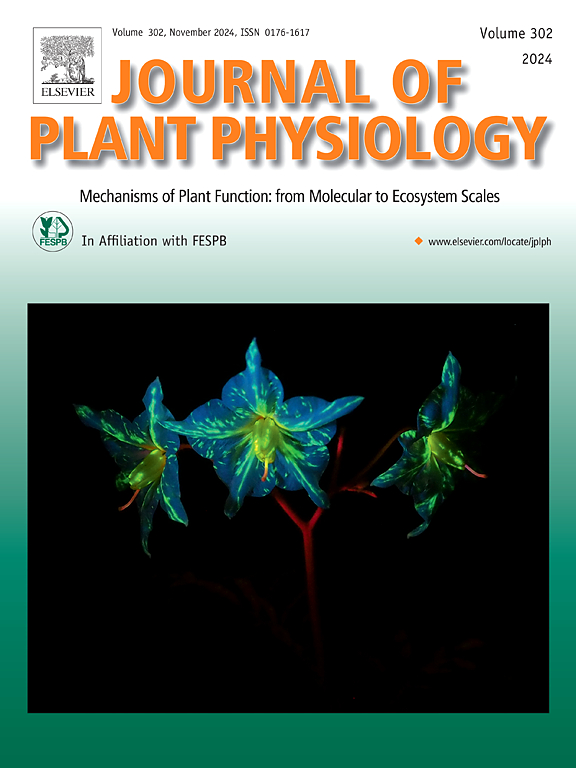Regulation of iron homeostasis by IMA1 and bHLH104 under phosphate starvation in Arabidopsis
IF 4
3区 生物学
Q1 PLANT SCIENCES
引用次数: 0
Abstract
Phosphate (Pi) starvation disrupts iron (Fe) nutrition at phenotypic, physiological, and transcriptional levels. The alteration of Fe homeostasis plays an important role in the adaptive response to Pi starvation. However, utilizing the antagonistic mechanism between P and Fe nutrition to improve adaptation to Pi deficiency in plants still needs to be explored. Here, we constructed inducible and constitutive expression of Fe regulators IMA1 and bHLH104, driven by the CaMV 35S promoter and the promoters of Pi-starvation responsive genes (proIPS1 and proPHT1;4), respectively. The Fe regulators bHLH104 and IMA1 were successfully upregulated in a constitutive and inducible manner under Pi deficiency in these transgenic plants. Regardless of Pi condition, upregulation of bHLH104 and IMA1 had no significant influence on primary root length or root Fe distribution. Nevertheless, the upregulation of bHLH104 and IMA1 induced Fe accumulation in the shoots of transgenic plants, particularly under Pi deficiency. Correspondingly, shoot chlorophyll content increased under Fe deficiency in the transgenic plants. In addition, in situ FeIII distribution revealed that bHLH104 and IMA1 likely interfere with Fe distribution through different pathways. The inducible upregulation of IMA1 significantly led to shoot zinc (Zn) accumulation under Pi deficiency, while the inducible upregulation of bHLH104 resulted in a decrease in shoot Zn and manganese (Mn) contents. The enhancement of Fe and Zn accumulation under the inducible expression of IMA1 under Pi deficiency was attributed to the induction of high expression of key Fe-uptake genes FRO2 and IRT1. The expression of the Zn and Mn uptake genes was also affected in these transgenic plants, which correlated with the changes in Zn and Mn contents. Overall, IMA1 is an excellent candidate for enhancing plant Fe and Zn accumulation and can be specifically induced under conditions of Pi deficiency.

拟南芥在磷酸盐饥饿条件下IMA1和bHLH104对铁稳态的调控
磷酸盐(Pi)饥饿在表型、生理和转录水平上破坏铁(Fe)营养。铁稳态的改变在水稻对缺铁的适应性反应中起重要作用。然而,利用磷铁营养之间的拮抗机制来提高植物对缺磷的适应能力仍有待探索。在这里,我们构建了铁调控因子IMA1和bHLH104的诱导和组成表达,分别由CaMV 35S启动子和pi饥饿应答基因启动子(proIPS1和prot1;4)驱动。铁调控因子bHLH104和IMA1在缺磷条件下成功地以组成型和诱导方式上调。无论Pi条件如何,上调bHLH104和IMA1对主根长度和根铁分布均无显著影响。然而,bHLH104和IMA1的上调诱导了转基因植株的铁积累,特别是在缺磷条件下。相应的,缺铁条件下转基因植株茎部叶绿素含量增加。此外,原位FeIII分布表明bHLH104和IMA1可能通过不同途径干扰Fe分布。在缺磷条件下,IMA1诱导上调显著导致地上部锌(Zn)积累,bHLH104诱导上调导致地上部锌和锰(Mn)含量降低。缺磷条件下IMA1的诱导表达促进了铁和锌的积累,其原因是诱导了关键的铁吸收基因FRO2和IRT1的高表达。这些转基因植株的锌和锰吸收基因的表达也受到影响,这与锌和锰含量的变化有关。综上所述,IMA1是促进植物铁和锌积累的极好候选基因,在缺磷条件下可以特异性诱导。
本文章由计算机程序翻译,如有差异,请以英文原文为准。
求助全文
约1分钟内获得全文
求助全文
来源期刊

Journal of plant physiology
生物-植物科学
CiteScore
7.20
自引率
4.70%
发文量
196
审稿时长
32 days
期刊介绍:
The Journal of Plant Physiology is a broad-spectrum journal that welcomes high-quality submissions in all major areas of plant physiology, including plant biochemistry, functional biotechnology, computational and synthetic plant biology, growth and development, photosynthesis and respiration, transport and translocation, plant-microbe interactions, biotic and abiotic stress. Studies are welcome at all levels of integration ranging from molecules and cells to organisms and their environments and are expected to use state-of-the-art methodologies. Pure gene expression studies are not within the focus of our journal. To be considered for publication, papers must significantly contribute to the mechanistic understanding of physiological processes, and not be merely descriptive, or confirmatory of previous results. We encourage the submission of papers that explore the physiology of non-model as well as accepted model species and those that bridge basic and applied research. For instance, studies on agricultural plants that show new physiological mechanisms to improve agricultural efficiency are welcome. Studies performed under uncontrolled situations (e.g. field conditions) not providing mechanistic insight will not be considered for publication.
The Journal of Plant Physiology publishes several types of articles: Original Research Articles, Reviews, Perspectives Articles, and Short Communications. Reviews and Perspectives will be solicited by the Editors; unsolicited reviews are also welcome but only from authors with a strong track record in the field of the review. Original research papers comprise the majority of published contributions.
 求助内容:
求助内容: 应助结果提醒方式:
应助结果提醒方式:


